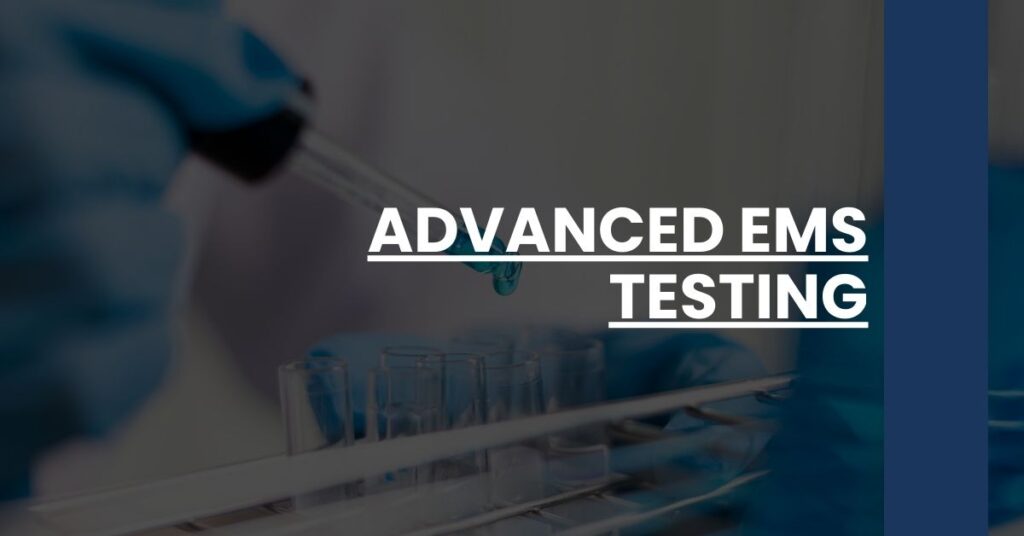Advanced EMS testing primes candidates for the pivotal role they’ll play in emergency medical services.
- Critical Skills: Advanced EMS testing evaluates the necessary cognitive and psychomotor abilities for lifesaving interventions.
- Public Safety: Rigorous exams ensure that EMS professionals meet high standards, directly impacting community health.
- Ongoing Development: Reflects the latest in clinical practice, keeping responders at the cutting edge.
Unlock the full potential of Advanced EMS testing for superior emergency care.
- Understanding Advanced EMS Testing
- The Importance of Advanced EMS Assessments
- Components of Advanced EMS Testing
- How Advanced EMS Testing Evolves with Technology
- Preparing for Advanced EMS Examinations
- Challenges and Controversies Surrounding EMS Testing
- The Future of Advanced EMS Testing
- Conclusion: Embracing the Rigor of Advanced EMS Testing
Understanding Advanced EMS Testing
When you search for “Advanced EMS testing,” you’re not just looking for any test; you’re diving into a complex, multifaceted process designed to assess the expertise and readiness of those who stand on the front lines of medical emergencies. Advanced EMS testing isn’t just about knowing facts; it’s about applying them in high-pressure situations to save lives.
Who Benefits from Advanced EMS Testing?
Primarily, high-level emergency medical services personnel, like paramedics, who need certification or recertification undergo this testing. As a candidate, these evaluations validate your proficiency and ensure that you embody the competencies required for the unpredictable nature of the job.
Types of Advanced EMS Evaluations
- Cognitive Assessments: Rigorous written or computer-based tests covering five core content areas, including airway management, cardiology, medical emergencies, and more.
- Psychomotor Exams: Hands-on practical tests that evaluate one’s ability to perform emergency medical services procedures under pressure.
- Scenario-Based Assessments: Simulations of real-life emergencies to test on-the-spot decision-making and application of skills.
Testing is both a checkpoint and a launchpad, ensuring that professionals can provide the most current and effective EMS care.
The Importance of Advanced EMS Assessments
In the realm of emergency healthcare, the margin for error is slim to none. Advanced EMS tests are meticulous for a reason – they ensure that those responsible for lives can act with precision and confidence. These tests are not just assessments; they are safeguards for public health.
The Role of Rigorous Testing in Public Safety
Being entrusted with the power to reverse life-threatening situations comes with an obligation to maintain exceptional standards. Imagine advanced EMS testing as the gatekeeper of quality assurance, validating that each respondent possesses necessary skills that can mean the difference between life and death.
Components of Advanced EMS Testing
Let’s dissect what makes up the structure of these crucial evaluations.
Cognitive Abilities
To pass advanced EMS tests, respondents must excel in areas that stretch from pharmacology to trauma. This component challenges one’s retention of knowledge and the ability to apply it effectively.
Psychomotor Skills
How do you react when an emergency stares you in the face? Psychomotor testing assesses this, rating your performance in lifesaving interventions without the luxury of time to ponder.
Scenarios: Where Theory Meets Practice
Scenarios are the ultimate test of agility and adaptability, pushing candidates to navigate through unpredictable conditions with finesse.
How Advanced EMS Testing Evolves with Technology
The nexus of technology and EMS testing is a dynamic one, with digital advancements opening up new frontiers for evaluating life-saving skills.
Embracing the Digital Age
Technology is not stagnant, and neither are testing methods. Modern simulation tools now provide immersive environments that replicate real-world situations, allowing for a more accurate assessment of a candidate’s practical competence.
Innovations on the Horizon
With technologies like virtual reality becoming more prevalent, we’re on the cusp of experiencing testing environments that blur the lines between test and reality, enhancing the EMS professional’s ability to adapt to the genuine complexities of emergency scenarios.
Advanced EMS testing has come a long way, but its evolution is far from over. As candidates and professionals in the field, embracing the cutting-edge methods that come to play will ensure that the EMS community stays equipped and ready for any emergency.
Preparing for Advanced EMS Examinations
Navigating the roadmap to ace your advanced EMS testing requires a blend of focused study, hands-on practice, and strategic exercises. This preparation is not merely about memorization—it’s about understanding and applying complex concepts in high-pressure situations. Here’s a comprehensive guide to get you ready for this challenge.
Sharpen Your Cognitive Prowess
Cognitive assessments form the backbone of advanced EMS testing, where the depth and breadth of your knowledge are thoroughly examined.
- Study Guides and Resources: Utilize reputable study guides to identify areas for improvement. These should be used as tools, not crutches, ensuring an honest appraisal of your readiness.
- Consistent Review: Regularly revisit core concepts from each of the five major content areas, ensuring that your theoretical knowledge stays sharp.
Hone Psychomotor Skills
Your ability to perform under pressure is a cornerstone of EMS proficiency. It’s crucial to translate theoretical knowledge into real-world rescue skills.
- Practical Exercises: Engage in hands-on practice sessions to reinforce procedural memory.
- Simulation: If possible, participate in simulated scenarios to elevate your readiness for the unpredictability of emergency situations.
Simulate Real-Life Scenarios
Advanced EMS testing will often place you in the middle of a situational crisis where decision-making is pivotal.
- Mock Scenarios: Create or participate in mock scenarios that reflect possible real-life emergencies.
- Peer Feedback: Actively seek feedback from your peers or instructors to refine your approach and tactics.
Engage in Continuous Learning
The medical field is ever-evolving, with continual advancements and updates. Stay current with the latest protocols and best practices through:
- Professional Development: Attend workshops, seminars, and continuing education courses.
- Medical Journals and Publications: Keep abreast of emerging trends and research.
Preparing for advanced EMS testing is a rigorous yet rewarding journey. With these strategies, you’ll not only face your examination with confidence, but you’ll also forge a path of lifelong learning in the pursuit of excellence within EMS.
Challenges and Controversies Surrounding EMS Testing
The landscape of advanced EMS testing is not without its obstacles and points of contention. Various stakeholders in the EMS community have voiced concerns over the fairness, accessibility, and practical relevance of these tests. Let’s examine these challenges and how they shape the debate.
Balancing Theory and Practice
EMS professionals must be adept at applying theoretical knowledge in dynamic, often chaotic environments. The debate rages on:
- Practicality in Exams: Does the current testing format adequately measure real-world applicability?
- Hands-On Experience: Are candidates being tested in scenarios that mirror the high-stress situations they will encounter in the field?
Access and Equity
The pathway to certification should be devoid of roadblocks related to geography or socio-economic status. Discussions focus on:
- Remote and Rural Access: Ensuring that candidates, regardless of location, have equal opportunities to take the tests.
- Costs and Resources: Addressing the financial burden and availability of resources for all candidates.
By shining a light on these issues, the EMS community can strive for a testing environment that is not just rigorous, but also fair and inclusive, ensuring that the best and brightest can serve, regardless of their background.
The Future of Advanced EMS Testing
The heartbeat of advanced EMS testing is its ability to adapt and evolve. As we look to the future, it’s apparent that testing protocols will undergo significant transformations to cater to new healthcare dynamics and technological breakthroughs.
Predictive Analytics
Imagine the power of predictive analytics informing EMS testing, creating examinations that are deeply customized to individual learning patterns and areas of improvement. This could lead to a future where tests are not only standardized but also intricately personalized.
Gamification and Immersive Learning
Gamification and virtual reality are knocking on the door of advanced EMS testing. They promise a world where learning and assessment are not disjointed experiences but rather a seamless blend of engagement and evaluation.
AI-Driven Simulations
Artificial intelligence stands to revolutionize scenario-based testing with simulations that are unfathomably realistic, offering an unparalleled depth of experience and preparation to candidates.
As you align with these emergent trends, you command a vantage point that helps establish you not just as an EMS practitioner but as a visionary, ready to embrace the changes that lie ahead in the realm of emergency medicine.
Conclusion: Embracing the Rigor of Advanced EMS Testing
Advanced EMS testing is more than a series of hurdles to overcome; it’s a commitment to professional excellence and reliability. The journey to mastering these tests is arduous, yet it’s a testament to your dedication to providing the highest level of emergency medical care. By embracing the rigorous nature of this endeavor, you reinforce a bedrock of trust within the community you serve and affirm your readiness to tackle any emergency that calls your name. With this mindset, let’s continue to champion advancements and optimize our preparedness for the unforeseen challenges of tomorrow.
Advanced EMS testing ensures top-quality emergency medical care. Explore its importance, evolution, and preparation strategies for EMS professionals.

